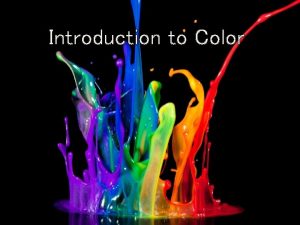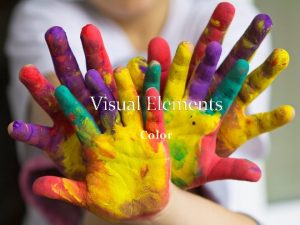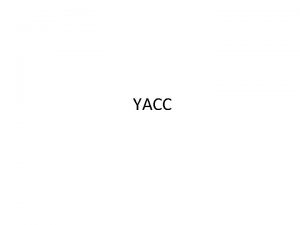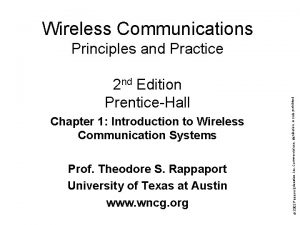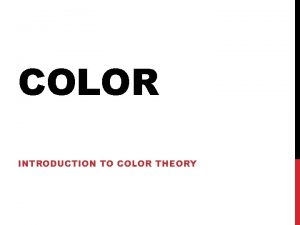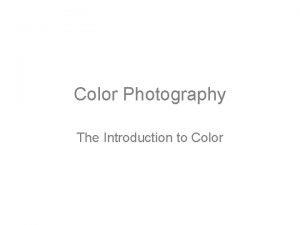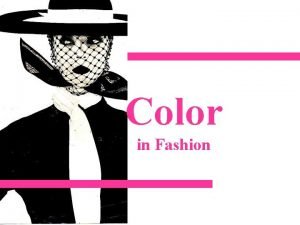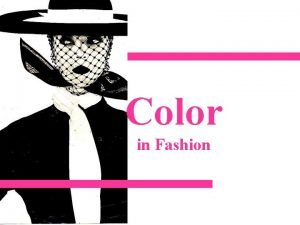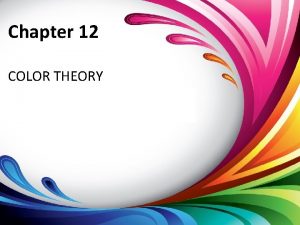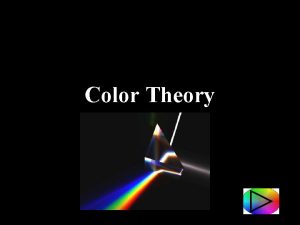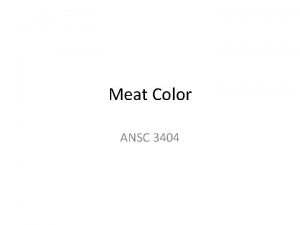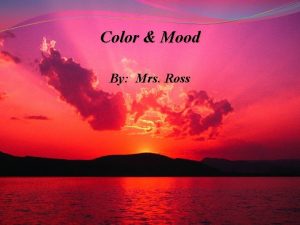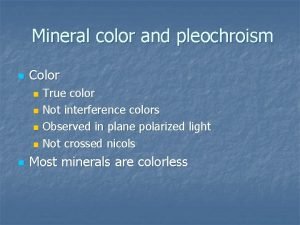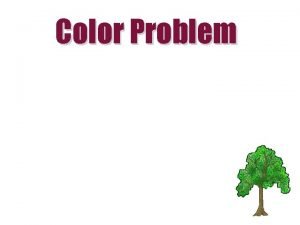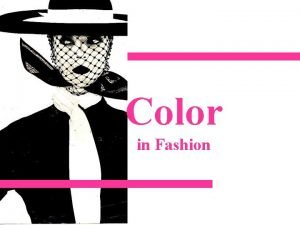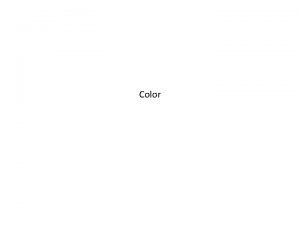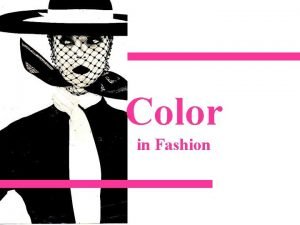Introduction to Color What is color Color is




































- Slides: 36

Introduction to Color



What is color? • Color is the aspect of things that is caused by differing qualities of light being reflected or emitted by them. • To see color, you have to have light. When light shines on an object some colors bounce off the object and others are absorbed by it. Our eyes only see the colors that are bounced off or reflected.

Light Gives Us the Color of the Rainbow

How do we see color? • Color is a way that we describe an object based on the way that it reflects or emits light. • Your eye can see different colors because a part of your eye called the retina is sensitive to different wavelengths of light. Let’s look at the science behind it!

The Color Wheel • A color circle, based on red, yellow and blue, is traditional in the field of art. Sir Isaac Newton developed the first circular diagram of colors in 1666. Since then, scientists and artists have studied and designed numerous variations of this concept.


• Primary Colors: Red, yellow and blue In traditional color theory (used in paint and pigments), primary colors are the 3 pigment colors that can not be mixed or formed by any combination of other colors. All other colors are derived from these 3 hues.

• Secondary Colors: Green, orange and purple These are the colors formed by mixing the primary colors.



Tertiary Colors • These are the colors formed by mixing a primary and a secondary color.

Complimentary Colors • Complementary colors are pairs of colors which, when placed next to each other, they create the strongest contrast for those particular two colors. Like the contrast between black and white. • Complementary colors are located directly across from each other on the color wheel.

Analogous Colors • Analogous colors are groups of three colors that are next to each other on the color wheel

What is a Hue? • What's the difference between a Hue and a Color? Most people, even the pros, get confused about this. Basically they mean the same thing and can be used interchangeably. • The words are a general terms to describe the color family on the Basic Color Wheel that your swatch is rooted in. They indicate the root of the variations we see. To make things simpler, think of a Hue as one of the twelve colors on the mixing wheel. • Burgundy = the root Color or Hue is RED • Navy = the root Color or Hue is BLUE • Rust = the root Color or Hue is ORANGE

Cool VS. Warm Colors

Warm Colors • Warms colors appear to be energetic and more stimulating.

Cool Colors • Cool colors appear to be calm and relaxing

Ways To Alter Colors • Every individual color on the Basic Color Wheel can be altered in three ways by – Tinting – Shading – Toning.

Tinting • A Tint is sometimes called a Pastel. Basically it's simply any color with white added.

Shading • A Shade is simply any color with black added.

Tint VS. Shade

Toning • A Tone is created by adding both White and Black which is grey. Any color that is "greyed down" is considered a Tone.

Monochromatic • Monochromatic colors are all the colors (tints, tones, and shades) of a single hue.

Polychromatic • Two or more colors; multicolored.

Achromatic • Means without color.

Neutral Colors • Neutral colors help to put the focus on other colors or serve to tone down colors that might otherwise be overpowering on their own. • To some extent blacks, browns, tans, golds, and beige colors are considered warm. • While white, ivory, silver, and gray are somewhat cooler colors








 Body paragraph structure
Body paragraph structure Introduction of colours
Introduction of colours A color scheme is the color spectrum bent into a circle
A color scheme is the color spectrum bent into a circle Color groupings that provide distinct color harmonies
Color groupings that provide distinct color harmonies In the fol sentence color(grass, green), color is
In the fol sentence color(grass, green), color is What is learning without burden
What is learning without burden What is yacc
What is yacc Dare paragraph
Dare paragraph Essay introduction examples
Essay introduction examples Abstract vs introduction
Abstract vs introduction Long introduction
Long introduction Email writing topics
Email writing topics Conclusion paragraph structure
Conclusion paragraph structure Introduction answer the question
Introduction answer the question How to write an imformative essay
How to write an imformative essay Editorial example
Editorial example How to start advantages and disadvantages essay
How to start advantages and disadvantages essay Background of the study
Background of the study How to write a diary entry
How to write a diary entry Character description essay example
Character description essay example Schaffer paragraphs
Schaffer paragraphs Mesopotamian civilization conclusion
Mesopotamian civilization conclusion Prayer for work immersion portfolio
Prayer for work immersion portfolio Wireless communication introduction
Wireless communication introduction Band introduction speech
Band introduction speech Introduction of personal selling
Introduction of personal selling Humour introduction
Humour introduction Closing remark for informal letter
Closing remark for informal letter Thematic essay examples
Thematic essay examples Good introduction paragraph
Good introduction paragraph Conclusion of smart note taker
Conclusion of smart note taker Introduction to e business
Introduction to e business Introduction to semiconductors
Introduction to semiconductors Infosys 222
Infosys 222 How is water transported in humans
How is water transported in humans Introduction to acids and bases webquest
Introduction to acids and bases webquest Introduction to dynamic web content
Introduction to dynamic web content

